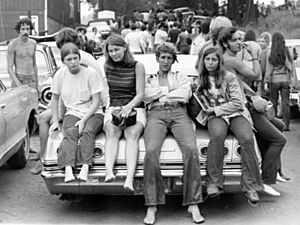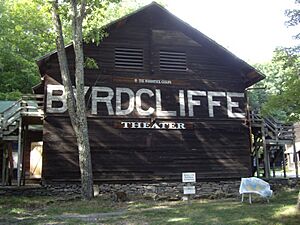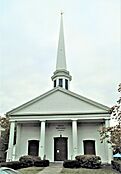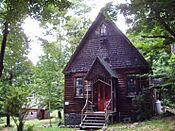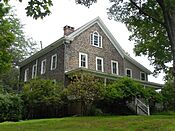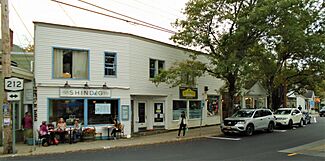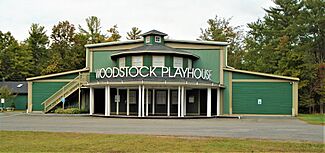Woodstock, New York facts for kids
Quick facts for kids
Woodstock, New York
|
|
|---|---|
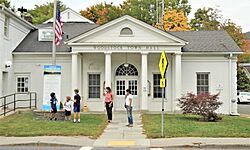
Town hall on Tinker Street (NY 212)
|
|
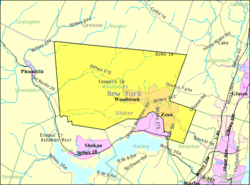
U.S. Census map
|
|
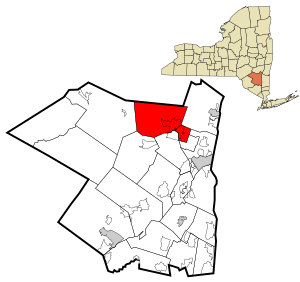
Location in Ulster County and the state of New York.
|
|
| Country | United States |
| State | New York |
| County | Ulster |
| Area | |
| • Total | 67.83 sq mi (175.69 km2) |
| • Land | 67.29 sq mi (174.28 km2) |
| • Water | 0.54 sq mi (1.41 km2) |
| Elevation | 1,444 ft (440 m) |
| Population
(2020)
|
|
| • Total | 6,287 |
| • Density | 93.43/sq mi (36.07/km2) |
| Time zone | UTC-5 (Eastern (EST)) |
| • Summer (DST) | UTC-4 (EDT) |
| ZIP code |
12498
|
| Area code(s) | 845 |
| FIPS code | 36-83052 |
| GNIS feature ID | 0979655 |
Woodstock is a charming town located in Ulster County, New York. It's in the northern part of the county, a bit northwest of Kingston. This town is special because it's inside the beautiful Catskill Park. In 2020, about 6,287 people lived here, which was more than in 2010.
Contents
History of Woodstock
People first started settling in Woodstock around 1770. The town of Woodstock was officially created in 1787. Over time, parts of Woodstock were used to form other towns like Middletown (in 1789), Windham (1798), Shandaken (1804), and Olive (1853).
Woodstock's Artistic Beginnings
In the late 1800s, Woodstock became a popular spot for Hudson River School painters. The Arts and Crafts Movement arrived in 1902 when artists like Ralph Radcliffe Whitehead, Bolton Brown, and Hervey White started the Byrdcliffe Colony.
In 1906, L. Birge Harrison and others opened the Summer School of the Art Students League of New York here. They mainly focused on landscape painting. Since then, Woodstock has been known as a lively place for artists. From 1915 to 1931, Hervey White's Maverick Art Colony hosted the Maverick Festivals. Hundreds of creative people gathered each summer for music, art, and theater in the woods.
The Woodstock Sound-Outs
From 1967 to 1970, a series of Woodstock Sound-Outs took place just outside town in Saugerties. These events featured folk and rock musicians like Richie Havens, Paul Butterfield, Dave van Ronk, and Van Morrison. They helped build Woodstock's fame as a summer arts center. The Sound-Outs even inspired the organizers of the famous Woodstock Festival to plan their concert nearby. However, the festival ended up being held in Bethel, New York, because Saugerties didn't give them a permit.
Spiritual Center
Woodstock is also home to the Karma Triyana Dharmachakra Buddhist monastery. This peaceful place is located at the top of Mead's Mountain Road.
Geography and Nature
Woodstock covers a total area of about 175.7 square kilometers (67.8 square miles). Most of this is land (174.3 square kilometers or 67.3 square miles), with a small amount of water (1.4 square kilometers or 0.54 square miles).
The northern border of the town is also the border of Greene County.
Population and People
| Historical population | |||
|---|---|---|---|
| Census | Pop. | %± | |
| 1820 | 1,317 | — | |
| 1830 | 1,376 | 4.5% | |
| 1840 | 1,691 | 22.9% | |
| 1850 | 1,650 | −2.4% | |
| 1860 | 1,858 | 12.6% | |
| 1870 | 2,022 | 8.8% | |
| 1880 | 1,968 | −2.7% | |
| 1890 | 1,628 | −17.3% | |
| 1900 | 1,675 | 2.9% | |
| 1910 | 1,647 | −1.7% | |
| 1920 | 1,488 | −9.7% | |
| 1930 | 1,652 | 11.0% | |
| 1940 | 1,983 | 20.0% | |
| 1950 | 2,271 | 14.5% | |
| 1960 | 3,836 | 68.9% | |
| 1970 | 5,714 | 49.0% | |
| 1980 | 6,823 | 19.4% | |
| 1990 | 6,290 | −7.8% | |
| 2000 | 6,241 | −0.8% | |
| 2010 | 5,884 | −5.7% | |
| 2020 | 6,287 | 6.8% | |
| U.S. Decennial Census | |||
In 2000, there were 6,241 people living in Woodstock. The population density was about 92.5 people per square mile. Most residents (94.25%) were white. About 1.30% were African American, and 1.57% were Asian. People of Hispanic or Latino background made up 2.56% of the population.
The average age in Woodstock was 48 years old. About 18.0% of the population was under 18. Around 38.0% were between 45 and 64 years old. The median income for a household was $49,217. For families, the median income was $65,938.
Music and Art in Woodstock
Woodstock is famous for its name being used for the Woodstock Festival. However, that huge music event actually happened about 60 miles away in Bethel. The festival was never meant to be in Woodstock itself.
Byrdcliffe Art Colony
The Byrdcliffe Colony started in 1903. It's one of the oldest Arts & Crafts colonies in the country. This colony brought the first artists to Woodstock. They taught and created furniture, metal items, ceramics, and weaving. Byrdcliffe also started Woodstock's first painting school. It completely changed the cultural landscape of the town.
Maverick Music Festival
In 1916, Hervey White, a philosopher and poet, built a "music chapel" in the woods. This became the home of the Maverick music festival. It's the longest-running summer chamber music festival in the United States. It's still held every year! Famous Composers like Henry Cowell and John Cage created music that was first played there. Today, this special concert hall is a historic site. World-class musicians play there from June to September.
Art Organizations and Schools
The Woodstock Artists Association and Museum (WAAM) was founded in 1919. It was started by artists like John F. Carlson and Frank Swift Chase. The WAAM has a collection of works by important American artists connected to the area. These include Milton Avery, George Bellows, and Doris Lee.
The Art Students League of New York had its summer school in Woodstock for many years. It was here from 1906 to 1922, and again from 1947 to 1979. The Woodstock School of Art has been teaching art since 1980.
The Woodstock Guild was started by Byrdcliffe artists in 1939. It now takes care of the 350-acre Byrdcliffe Colony. This organization hosts art shows, classes, concerts, and dance events. It also runs the oldest craft shop in Woodstock, the Fleur de Lis Gallery. Voice Theatre now has its home at the Byrdcliffe Theater. Byrdcliffe is listed on the National Register of Historic Places and is still a haven for artists today.
Modern Festivals
In 1981, Woodstock hosted the Woodstock Jazz Festival. This event celebrated the Creative Music Studio, which was founded by Karl Berger and Ornette Coleman. Famous musicians like Jack Dejohnette and Chick Corea performed there.
From April 19-22, 2012, Woodstock also hosted the Woodstock Writers Festival. Authors like Ann Hood and Augusten Burroughs gave talks and workshops.
Woodstock is also home to the Woodstock Film Festival, which started in 2000. This film festival is very important because it helps short films qualify for the Oscar® awards.
Education in Woodstock
Most of the schools in Woodstock are part of the Onteora Central School District. A small part of the town is in the Saugerties Central School District. Students in that area attend Saugerties High School.
Famous People from Woodstock
Woodstock has always attracted artists, musicians, actors, and writers. This was true even before the music festival made the name "Woodstock" famous. The town even has a special "Artist's Cemetery." Film and art festivals bring in many well-known people. Hundreds of musicians have come to Woodstock to record music. Early pioneers included Bob Dylan and later, Joe Cocker. Many musicians performed at a bar called the Joyous Lake, which became world-famous.
Another person who once lived in Woodstock was Lee Marvin, a famous actor. His acting career began when he filled in for a sick actor at the Woodstock Theater.
Local Communities and Landmarks
- Artists' Cemetery – A special cemetery for artists and important people from Woodstock. It's on Rock City Road.
- Ashokan Reservoir – A large reservoir that provides water to New York City. Nine old towns are now underwater beneath it.
- Bearsville – A small community west of Woodstock village.
- Byrdcliffe – The site of the first art colony in Woodstock. It's northwest of Woodstock village.
- Church of the Holy Transfiguration of Christ-on-the-Mount – A beautiful church in the area.
- Cooper Lake – A Kingston reservoir located south of Lake Hill.
- Daisy – A community east of Woodstock, sometimes called East Woodstock. It's known for stone cairns and other possible ancient sites.
- Echo Lake – A mountain lake in the Catskill Mountains.
- Judge Jonathan Hasbrouck House – A historic house listed on the National Register of Historic Places.
- Lake Hill – A small community just west of Shady.
- Mead's Meadow (Woodstock) – Also known as "The Magic Meadow," this was once a cow pasture. It's near the Karma Triyana Dharmachakra Tibetan Buddhist monastery and is an entrance to the Devil's Path hiking trail.
- Montoma – A community south of Woodstock, near the border with the Town of Hurley.
- Mount Guardian – A mountain west of Overlook Mountain.
- Mount Tobias – A mountain in the central part of the town.
- National Youth Administration Woodstock Resident Work Center – A historic work center.
- Ohayo Mountain – A mountain to the south, between the Ashokan Reservoir and Woodstock village.
- Opus 40 – A huge sculpture carved from local bluestone by Harvey Fite. It's located in Saugerties, near Woodstock.
- Overlook Mountain – A mountain to the northeast, where much of Woodstock is located on its lower slopes.
- Phoenicia, NY – A community about 13.5 miles west of Woodstock.
- Saugerties, New York – A nearby town that includes the Winston Farm, where Woodstock '94 was held. It also hosts the Garlic Festival and Horse Shows In The Sun (HITS).
- Saw Kill – A stream that flows through Woodstock and nearby communities.
- Shady – A community northwest of Byrdcliffe.
- Vosburg Turning Mill Complex – A historic mill complex.
- Willow – A community in the northwest part of the town.
- Wittenberg – A community southwest of Bearsville. It has Yankeetown Pond and the Kenneth Wilson State Campground.
- Woodstock – This refers to the main village area of Woodstock, where most services are found.
- Zena – A community east of Woodstock village.
Images for kids
See also
 In Spanish: Woodstock (Nueva York) para niños
In Spanish: Woodstock (Nueva York) para niños



